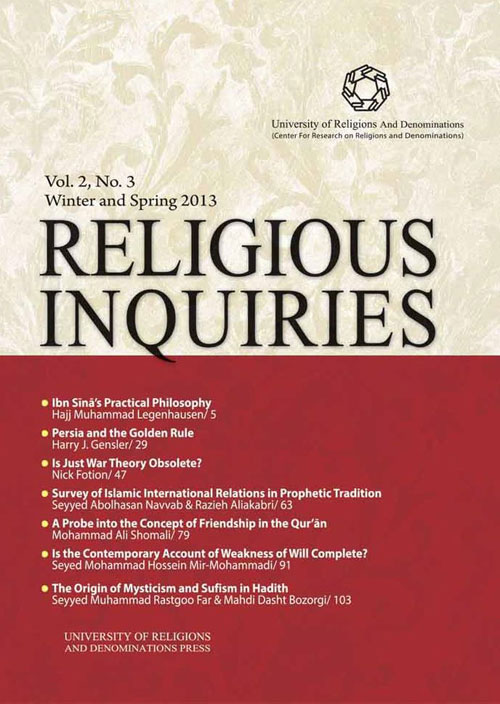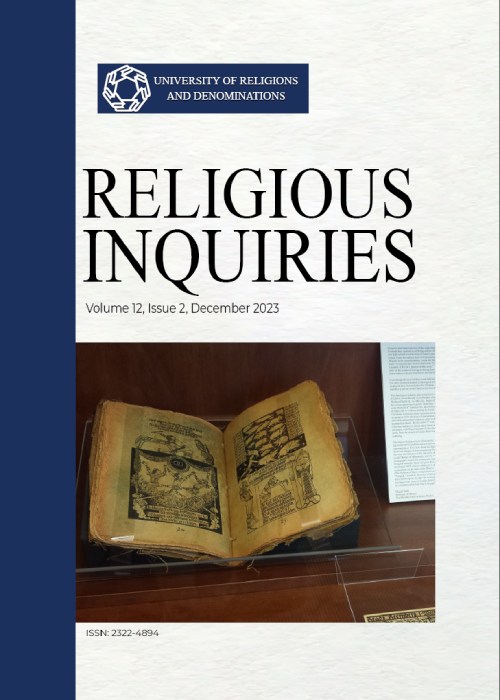فهرست مطالب

Religious Inquiries
Volume:8 Issue: 2, Summer and Autumn 2019
- تاریخ انتشار: 1398/09/10
- تعداد عناوین: 7
-
-
Pages 5-23
The Melkites, Jacobites, and Nestorians were the main Christian communities under Muslim rule. Several pre-Islamic Arab Christian authors wrote treatises concerning their beliefs in Arabic, some of which date back to the early Islamic centuries. The multiplicity of such polemical works suggests an intellectually open society and a degree of tolerance shown by Muslim leaders. Abu Raʾitah al-Takriti (d. 835) was one of the most influential Jacobite authors, who wrote treatises on the Trinity and Incarnation. His era shows the new challenges raised by Muslim surroundings, some of which were unprecedented in the Christian world. As such, Arab Christians like Abu Raʾitah were compelled to use new methods and respond to novel objections. Abu Raʾitah tried to explain the Trinity in the framework of Islamic theology (kalam). Therefore, he introduced the hypostases as God’s attributes. According to him, Knowledge (Speech) and Life are two substantial and eternal divine attributes. Abu Raʾitah also referred to the Bible and the Quran and used various analogies in order to defend the doctrine of the Trinity.
Keywords: Abu Raʾitah, Muʿtazilites, Trinity, hypostasis, Substance -
Pages 25-42In this paper, the scientific methodology of the contemporary philosopherImre Lakatos is revised to construct a methodology for theological systems. In this methodology, each theological system consists of the following main elements: (1) hard core I, (2) protective wall, (3) hard core II, and (4) auxiliary hypotheses. We will expound the criteria for the evaluation of different theological systems and show how a theological system prevails over other theological systems in the light of these criteria. These criteria are of two types: first, the criteria that we have presented for a successful and progressive theological system; second, the criteria mentioned in the philosophy of science for the evaluation of competitor scientific hypotheses and theories. In conclusion, we present the results of our proposed theological plan. Some of the results include preserving religion from distortion and deterioration, resolving the disputes over the relation between science and religion or reason and religion, and considering theology as a science parallel to other sciences.Keywords: explanation, Theology, methodology of theological theories
-
Pages 43-58
In this paper, I propose a new response to a particular instance of the problem of evil: the problem of animal suffering. My solution, in brief, is that the rational theist may argue, justifiably, that an omnipotent, omniscient, omnibenevolent God would not allow gratuitous animal suffering to occur, and, therefore, all instances of animal suffering that are encountered are not instances of gratuitous evil. I maintain that the justification for this response to the problem of evil does not depend on the availability of a persuasive argument for the existence of God. I will focus on one category of animal suffering: the gratuitous suffering of unseen animals. For reasons that will become clear, I think that this category of evil is the most difficult for the rational theist to explain. If this problem can be solved with my proposed defense, then, I think, any problem of animal suffering can be solved.
Keywords: Problem of Evil, theodicies, animal pain, gratuitous suffering -
Pages 59-80An important allegory throughout the history of philosophy is Plato’s allegory of the cave. There are remarkable similarities between this allegory and an allegory from Islamic philosophy—that of western exile (al-ghurba al-gharbiyya) proposed by Suhrawardī. This paper seeks to consider fundamental components and issues within the two allegories, including the issue of the soul as the true human essence, its immateriality and origin, the material world as a cave and Kairouan prison of the soul, and an immaterial world as a locus of light, knowledge, and perfection, as it is referred to by some as the world of the image (imaginal world or ʿālam al-mithāl) or the world of intellects (ʿālam al-ʿuqūl) and by others as the world of forms (ʿālam al-muthul). There is also an epistemological issue underneath both allegories regarding how knowledge is acquired and what true knowledge consists in. Although there are differences in thoughts and philosophies of the two philosophers, a commonality can be discerned between them in light of these allegories. The main points of this commonality are that knowledge constitutes the main essence of human happiness and that the soul as the immaterial human origin should seek release from the cave and Kairouan prison of the material world and return to its true abode—that is, the eastern world—because human perfection consists in the transcendence of his soul and its emancipation and arrival at pure truth, knowledge, and light.Keywords: allegory of the cave, allegory of the western exile, plato, Suhrawardī, comparative study
-
Pages 81-100
This Article, with a descriptive-analytical method and phenomenological approach, tries to explain the motives, solutions, and achievements of Dārā Shukūh (fl. 11th century AH) in Muslim-Hindu relations. It will also describe his ways of interaction and explain some negative reactions against his policies. Dārā Shukūh’s main motives were his special family upbringing, his chivalrous and artistic mentality, his adherence to the tolerant Qādirī Order, his companionship with educated Hindus, and the similarities he found between Islamic mysticism and Hinduism. In practice, he tried to promote rapprochement between Islamic denominations, further the tolerance of the Qādirī order, value Hindus, write books on the compatibility between Islamic and Hindu principles, have dialogues for resolving ambiguities, and to translate Hindu classic texts to promote mutual understanding. His activities led to the opposition of Hanafī jurisprudents and Naqshbandī Sufis, his banishment and excommunication, the decline of the tolerant Qādirīs against the intolerant Naqshbandīs, the establishment of relative and temporary balance between the Muslims and Hindus, the introduction of Hindu writings to the West through translation. Of course, presenting a practical model for Muslim-Hindu relations was the most important achievement of Dārā Shukūh, which can be used in today’s world.
Keywords: Dārā Shukūh, Hinduism, Islam, Muslim-Hindu relations, religious interaction, tolerance -
Pages 101-126
The so-called Islamic State (ISIS/ISIL) used the hadith mentioning that “the slave-girl will give birth to her master” to justify its renewal of sexual slavery. This hadith is talking about signs before the end of the world, so it could be interpreted by the same Temple theology technique that has been used in the biblical book of Revelation, which is also about the end of the world. “Temple theology” refers to the fact that many obscure and bizarre texts symbolically describe the rituals and politics of the Temple in Jerusalem. Thus, it will be argued that the whole hadith is talking about events that happened prior to the destruction of the Second Temple in Jerusalem in 70 CE (the Temple symbolized the world, so the end of the world refers to this incident). In particular, it will be shown that slave-girl refers to the Virgin Mary giving birth to Christ. The hadith is then linked to the start date of the building the Dome of the Rock in 688 CE, which is the year 999/1000 according to the “Seleucid Era” calendar, implying a nearness to a symbolic end of the world. As such, the “Islamic State” has no Islamic basis to use sexual slavery. As an appendix, the Dabiq hadith concerning the conquest of Constantinople is briefly discussed with reference to the possibility that Constantinople did fall to the Muslims before another symbolic end of the world, the year 7000 according to the Byzantine Calendar.
Keywords: Islamic State (ISIS, ISIL), end of the world, Temple theology, Essenes, Dabiq -
Pages 127-140
The controversies and theological debates between different religions have always been an interesting topic for the scholars of religion. These debates were usually carried out in two ways: orally, in a meeting dedicated to these debates, or in writing. One of the religious traditions criticized since its emergence and against which many refutations were written in the early Islamic centuries is “heterodoxy.” Before Islam, this term was applied to Manichaeans; however, after Islam, it came to signify any heretic, atheist, or infidel. This extension of semantic inclusion led the followers of various religions, including Christians, Zoroastrians and Muslims, to work against the heterodox and write refutations to criticize their thoughts and beliefs. This article seeks to study and analyze these refutations.
Keywords: Refutation, heterodoxy, Manichaeans, Zoroastrianism, Christianity, Islam


